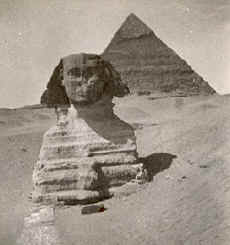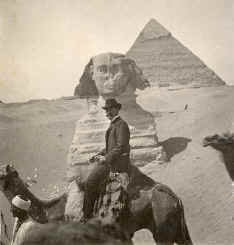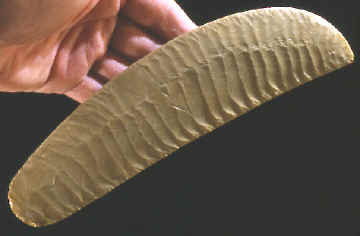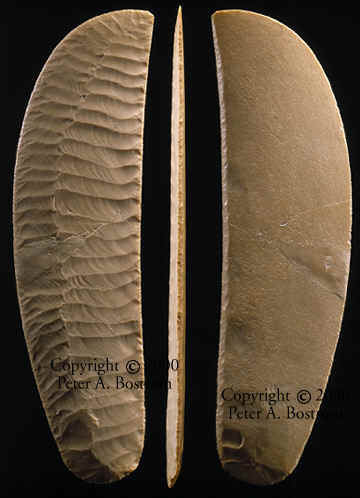|
OCTOBER
2000
GERZEAN KNIFE
PREDYNASTIC EGYPT
 
These pictures were taken by a doctor and his wife in 1903. The doctor is
sitting on the camel. These famous structures at Giza were built hundreds
of years after Gerzean knives were made. In fact, the first pyramid, known
as the stepped pyramid of Zoser at Saqqara, was built 500 years
after. These knives were being made just at a time when the first walled
cities in Egypt were constructed. Just after this period the emergence of
Dynastic civilization and the major institutions of Egyptian government
and religion are formed.
|
|
GERZEAN
"RIPPLE
FLAKED"
KNIFE
PREDYNASTIC
EGYPT
Some of the most skillfully flaked stone artifacts ever made during the
late Stone Age anywhere in the world are Gerzean "Ripple Flaked"
Knives. They represent a high point in flintknapping technology and are
characteristic of the Predynastic period of Egyptian prehistory. They date
to the Gerzean and early Protodynastic eras between 5,400 and 5,150 years
ago.
Gerzean knives took a long time to make if you compare them to
large knives from other cultures and time
periods. To make one, a stone of good quality was
first percussion flaked into the desired shape. Then both sides were
ground and polished smooth. The smooth surface was then uniformly removed,
on one side only, by pressure flaking. This unique style is only
found in Egypt but a similar manufacturing technique is also seen in some of
the different types of Neolithic daggers from Europe.
Most known examples of Gerzean knives have been purchased,
but it is presumed they came from looted tombs. Some documented examples
are known from tombs and rare broken specimens, from major settlement
sites. They were high status objects and may have been used in sacrificial
rites. In a few instances they have survived with richly decorated gold
foil and carved ivory handles. Motifs include goddesses, heroes and a
scene of a boat battle.
Many Ripple Flaked Gerzean knives show signs of deliberate
breaking, suggesting they were ritually
"killed" before being interred with the dead. This may have been
done to prevent
their magical continuance as weapons of carnage. |

GERZEAN RIPPLE FLAKED
KNIFE
PETE BOSTROM
COLLECTION

"CLICK HERE FOR
MAGNIFIED EDGE"
GERZEAN RIPPLE FLAKED
KNIFE
THREE VIEWS
SHOWING FLAKED AND POLISHED SIDES.
PETE BOSTROM COLLECTION
This Gerzean knife was apparently ritually "killed" by striking it
in the center of the blade. It measures 8 1/2 inches long and 2 3/16 inches
wide.
|